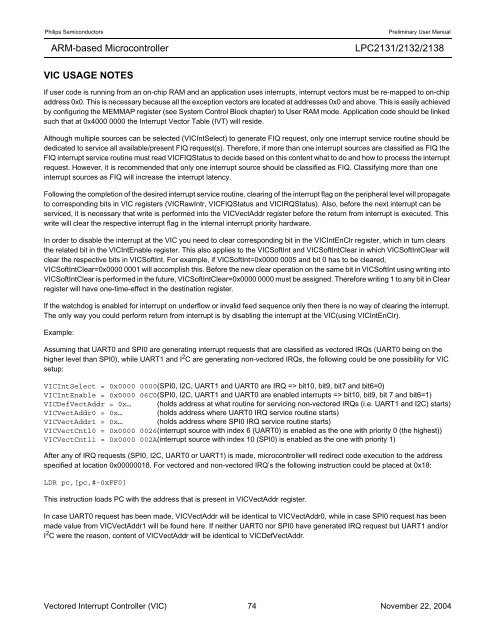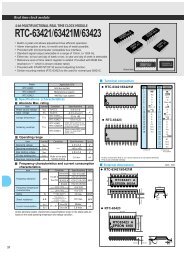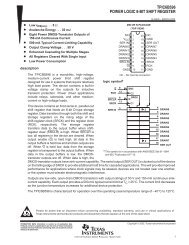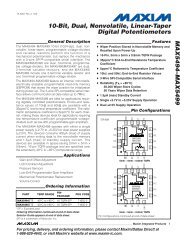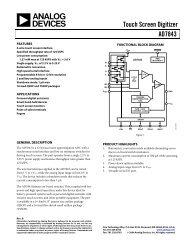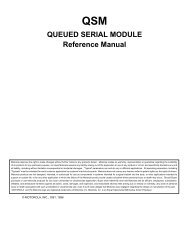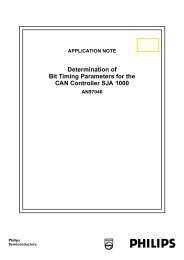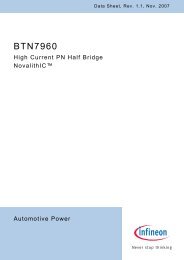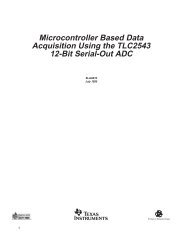You also want an ePaper? Increase the reach of your titles
YUMPU automatically turns print PDFs into web optimized ePapers that Google loves.
Philips Semiconductors Preliminary <strong>User</strong> <strong>Manual</strong><br />
ARM-based Microcontroller<br />
VIC USAGE NOTES<br />
<strong>LPC2131</strong>/<strong>2132</strong>/<strong>2138</strong><br />
If user code is running from an on-chip RAM and an application uses interrupts, interrupt vectors must be re-mapped to on-chip<br />
address 0x0. This is necessary because all the exception vectors are located at addresses 0x0 and above. This is easily achieved<br />
by configuring the MEMMAP register (see System Control Block chapter) to <strong>User</strong> RAM mode. Application code should be linked<br />
such that at 0x4000 0000 the Interrupt Vector Table (IVT) will reside.<br />
Although multiple sources can be selected (VICIntSelect) to generate FIQ request, only one interrupt service routine should be<br />
dedicated to service all available/present FIQ request(s). Therefore, if more than one interrupt sources are classified as FIQ the<br />
FIQ interrupt service routine must read VICFIQStatus to decide based on this content what to do and how to process the interrupt<br />
request. However, it is recommended that only one interrupt source should be classified as FIQ. Classifying more than one<br />
interrupt sources as FIQ will increase the interrupt latency.<br />
Following the completion of the desired interrupt service routine, clearing of the interrupt flag on the peripheral level will propagate<br />
to corresponding bits in VIC registers (VICRawIntr, VICFIQStatus and VICIRQStatus). Also, before the next interrupt can be<br />
serviced, it is necessary that write is performed into the VICVectAddr register before the return from interrupt is executed. This<br />
write will clear the respective interrupt flag in the internal interrupt priority hardware.<br />
In order to disable the interrupt at the VIC you need to clear corresponding bit in the VICIntEnClr register, which in turn clears<br />
the related bit in the VICIntEnable register. This also applies to the VICSoftInt and VICSoftIntClear in which VICSoftIntClear will<br />
clear the respective bits in VICSoftInt. For example, if VICSoftInt=0x0000 0005 and bit 0 has to be cleared,<br />
VICSoftIntClear=0x0000 0001 will accomplish this. Before the new clear operation on the same bit in VICSoftInt using writing into<br />
VICSoftIntClear is performed in the future, VICSoftIntClear=0x0000 0000 must be assigned. Therefore writing 1 to any bit in Clear<br />
register will have one-time-effect in the destination register.<br />
If the watchdog is enabled for interrupt on underflow or invalid feed sequence only then there is no way of clearing the interrupt.<br />
The only way you could perform return from interrupt is by disabling the interrupt at the VIC(using VICIntEnClr).<br />
Example:<br />
Assuming that UART0 and SPI0 are generating interrupt requests that are classified as vectored IRQs (UART0 being on the<br />
higher level than SPI0), while UART1 and I 2 C are generating non-vectored IRQs, the following could be one possibility for VIC<br />
setup:<br />
VICIntSelect = 0x0000 0000(SPI0, I2C, UART1 and UART0 are IRQ => bit10, bit9, bit7 and bit6=0)<br />
VICIntEnable = 0x0000 06C0(SPI0, I2C, UART1 and UART0 are enabled interrupts => bit10, bit9, bit 7 and bit6=1)<br />
VICDefVectAddr = 0x… (holds address at what routine for servicing non-vectored IRQs (i.e. UART1 and I2C) starts)<br />
VICVectAddr0 = 0x… (holds address where UART0 IRQ service routine starts)<br />
VICVectAddr1 = 0x… (holds address where SPI0 IRQ service routine starts)<br />
VICVectCntl0 = 0x0000 0026(interrupt source with index 6 (UART0) is enabled as the one with priority 0 (the highest))<br />
VICVectCntl1 = 0x0000 002A(interrupt source with index 10 (SPI0) is enabled as the one with priority 1)<br />
After any of IRQ requests (SPI0, I2C, UART0 or UART1) is made, microcontroller will redirect code execution to the address<br />
specified at location 0x00000018. For vectored and non-vectored IRQ’s the following instruction could be placed at 0x18:<br />
LDR pc,[pc,#-0xFF0]<br />
This instruction loads PC with the address that is present in VICVectAddr register.<br />
In case UART0 request has been made, VICVectAddr will be identical to VICVectAddr0, while in case SPI0 request has been<br />
made value from VICVectAddr1 will be found here. If neither UART0 nor SPI0 have generated IRQ request but UART1 and/or<br />
I 2 C were the reason, content of VICVectAddr will be identical to VICDefVectAddr.<br />
Vectored Interrupt Controller (VIC) 74 November 22, 2004


